“Faces of Tradition” by Tasha N.
Tasha N. guest-curated “Faces of Tradition” at ART123 Gallery in May 2024. The following is a blog post written by her to commemorate the show.
Some things in life just go together. Like peanut butter and jelly. Salt and pepper. Things like that. For me it’s my mom and beads. My entire life I’ve watched her make so many beautiful things out of them. Miniscule pieces of glass, shells and stone insignificant on their own but somehow she managed to weave them together to create intricate pieces of art. The hours, the talent and dedication she had to create these works has always been a source of pride for me. Every new thing she makes I love saying, “My mom made that!” As a kid, seeing her creativity shine through her beadwork pushed me to find the same kind of passion which opened different avenues of interests that have followed me into adulthood. Now today many of my own creative projects continue to be inspired by her and her art. The latest project being my guest curatorship at ART123, where I was given the opportunity to curate my own show, titled “Faces of Tradition”.
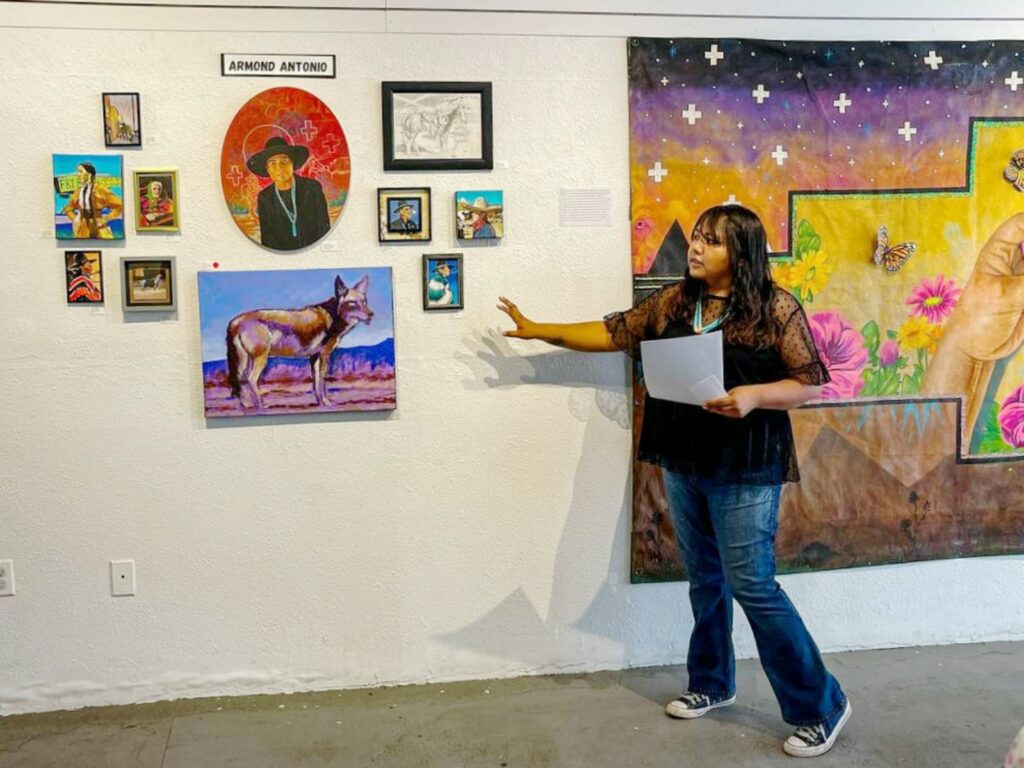
The show is very special to me because it’s an art show about a social justice theme I’m very passionate about: economic exploitation of Native artists. The show has different components that represent different parts of the social justice theme. There is a mural, painted portraits, a photo wall and artwork by several different artists. All of which we will explore in this post but first let’s talk about why I chose economic exploitation as my theme.
I grew up in a family of artisans and have seen first hand the disparity set between Native artists and Gallup’s Native arts industry and I was, for a short time, even a part of it. Sometimes I think about the irony of talking about these disparities because some may get the impression I don’t like Gallup when the exact opposite is true. I love this place. I was born here. It’s a part of my history and a part of who I am. But just as a child requires admonishment from a parent to grow and do better, I feel that Gallup needs to hear difficult truths in order to grow also.
Gallup has always had a notorious reputation for being a bordertown, something that even today is quite hard to shake. But Gallup has successfully called itself the “Indian Capital of the World” because of its proximity to various native communities and as so, it’s been able to build a lucrative economy based on its ease of access to native handcrafted/made art. It loves to boast about its proximity to native communities and that it’s “home to over 1,000 native american artisans” but in reality there are only a few places where someone can buy directly from a native artist. Gallup trading posts, private businesses and galleries are often muddled with brokers who have taken advantage of native artists through shortchanging/price gouging, counterfeiting and monopolizing the native arts and crafts industry. They’ve created an environment of anonymity and have perpetuated the idea that Native American art remains single faceted. All of which harms native artists, their livelihoods and undermines their creative efforts and essentially robs them of self-representation.
For this guest curator show I wanted to create a body of work that honors native artists and brings back the humanity that has been eroded by capitalism. It’s important to me that the community and visitors remember that behind Gallup’s success are real people who at the end of the day are fathers, mothers, grandmothers, etc… providing for their families. This show is my attempt at giving credit where it is rightly due and perhaps, rebuild a sense of transparency.
The Mural
This installation features my mother’s hands as the focal point, speaking to the legacy of hard work instilled by the matriarchs of Navajo families. Their hands built the local economy and in them we see strength, resiliency, creativity and entrepreneurship. It is through their hands that we prosper. This mural is a homage to the craftspeople and artisans in my family, and many other families, who have carried on and expanded traditions. It is especially a tribute to Diné (Navajo) women, who work all day, every day, from dawn until dusk to create all they can for us, their children, and their families. In my experience, the hard work put in by artists is more valued than the individual who created the work. Gallup exists because we, artists and craftspeople, exist. This mural reminds us, our community, and visitors of the essence of who we are.
Painted Portraits
In the show I painted seven portraits of artists that have worked in the area and that I know personally. I’ve always felt that portraiture is an intimate gesture. As you work and study the face of the subject you are having a sort of conversation with each brush stroke. Who is this person? What have they felt? Who are they to me? What do I want others to see about them? And is this portrait accurate? Painting these portraits was an act of reflection and with every curve and wrinkle I was reminded of how appreciative I am for the people in these portraits. The portraits include my partner, Shandiin DeGroat, a mixed-media artist. His mother, Elsie A. a silversmith. His grandmother, Ruth A. a weaver. His aunt, Cathy W., a silversmith. My little brother, Armond Antonio a painter. My grandfather, Edison Yazzie, a silversmith and my mother, Shelia N., a bead artist.
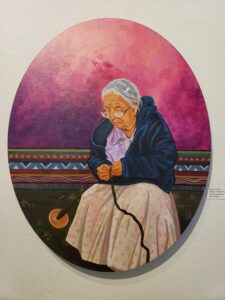 I wanted these portraits to serve as a reminder that behind works of art are individuals who have used their life stories, their creativity and talent to shape them and share with the world. That when we buy a painting, a silver piece of jewelry or drawing it’s not just the material object we are investing in but the legacy and livelihood of the artist who made it. It’s important for us as consumers to be conscious of what we are supporting.
I wanted these portraits to serve as a reminder that behind works of art are individuals who have used their life stories, their creativity and talent to shape them and share with the world. That when we buy a painting, a silver piece of jewelry or drawing it’s not just the material object we are investing in but the legacy and livelihood of the artist who made it. It’s important for us as consumers to be conscious of what we are supporting.
The Photo Wall
On the east wall of the gallery I created a photo wall that includes mixed media portraits of my family I created years ago, personal photos of my family and photos of artist friends and acquaintances I’ve met throughout the years. The aim I had with this photo wall was to express how vibrant and extensive the artistic community is beyond what we are presented with at trading posts and shops.
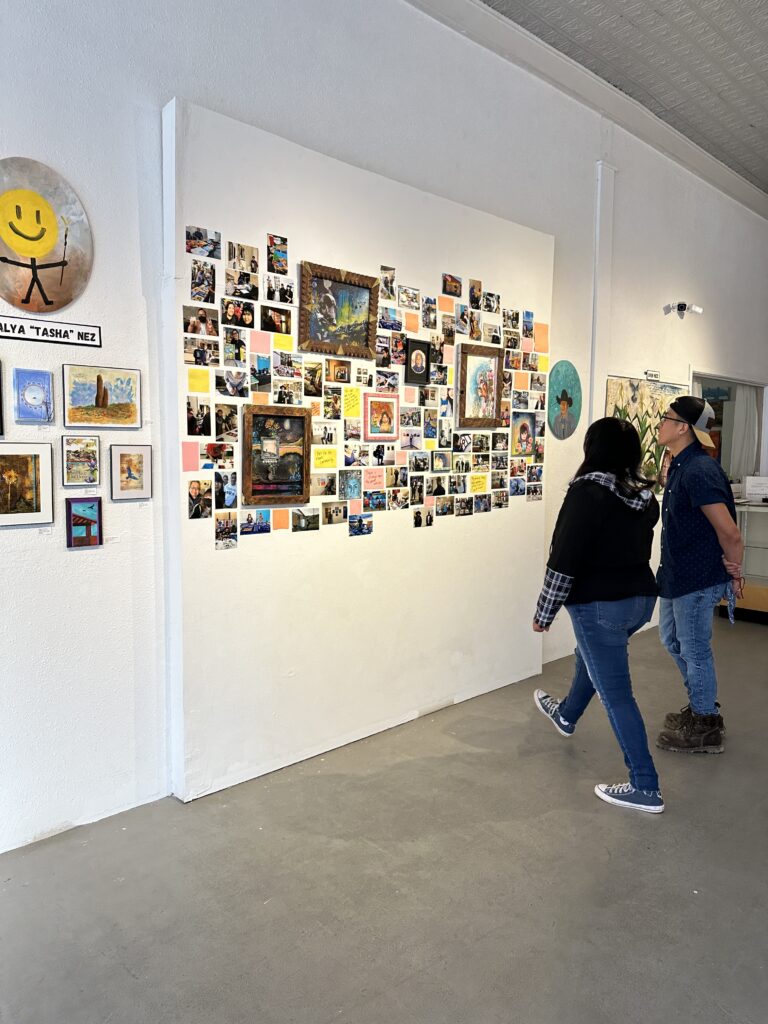
I’ve often thought about how superficial the thought behind Native American art can be especially in a town that presents itself as Gallup does. It’s no question that the work in these shops are impressive and full of rich history but the idea that Native American artwork can be contemporary artworks has yet to be embraced. Gallup’s economy is dependent on the idea that Native American artwork is Native artwork not because of the Native artist who made it but of the depictions in the work such as cowboys in a vast desert scene or portraits of stoic native men. Artwork which may be aesthetic and full of talent on the artists behalf but continue to leave much out.
Native artists are much more than what is presented at the surface in Gallup; there’s an entire community of artists who have found their niche within contemporary or traditional arts. The photo wall is a testament to the fact that we have silversmiths, textile artists, photographers, digital artists, mixed-media artists, sculpture artists, painters, watercolorists, abstract artists, etc… By interweaving personal photos, photos of artists and my own artwork I wanted to show the magnitude of the community I’ve been able to build through art and art that is representative of my own story. We don’t need a re-telling of our stories to be successful and I hope that it can also serve as an encouragement to aspiring artists to follow whatever dreams they may have.
Featured Artists
For this show it was an important aspect to include other artists into this opportunity and to have different types of artistry represented. Each artist has a unique style all their own and ties back into the idea that our stories and culture and how we present them are our own. I invited seven artists to present their own work next to the portrait I created of them and four of them took me up on that offer. I then invited four additional artists to feature their artwork throughout the show to bring it together. These artists include:
Valencia Edgewater-Chapito she is a member of the Dine tribe and was born in Gallup and graduated from Gallup High School. She currently lives in the Tse-Yah-Toh community. Her art has always been in her heart and has been making art for as long she can remember. She has fond memories of sitting with her sisters at night, creating in the soft yellow glow of a kerosene lamp and listening to the radio, munching on Doritos, pickles, and Pepsi. She would like to encourage everyone to make art and that there are so many ways to “make” like sewing, making music, painting, sculpting, writing, weaving, carving, and drawing.
Shelia N. is a bead artist from Ramah, New Mexico. She creates beaded sculptures, bead embroidered jewelry, encaustic art, mixed-media, and pottery etching. She is currently a full-time artist and creates work for select clientele. Her work is inspired by the things she loves–her family and faith. She has participated in a variety of group shows and public art installations in Gallup. You can find more of her work on Instagram at @muddyhilldesigns
Orin Nez is a contemporary Native artist working in the Gallup area. Cathy W. is a working silversmith from Superman Canyon, New Mexico.
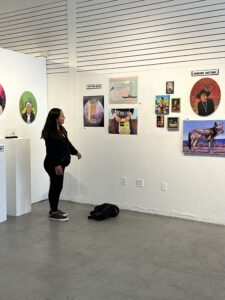 Peyton Alex is a self-taught graphic artist and second generation silversmith from Dilkon, Arizona, whose journey from traditional painting to digital art was catalyzed by the challenges of COVID-19 pandemic. Peyton creates vibrant digital artworks that highlight the dynamic spirit of female Native skaters. Inspired by her involvement with the Diné Skate Garden Project, Peyton’s work not only showcases the beauty and strength of Native culture but also provides representation that they felt was lacking during their own upbringing. Their pieces often feature traditional attire and elements from their upbringing, such as the mesas of their homeland and traditional aspects to inspire and empower the next generation. Peyton actively works with the Diné Skate Garden Project, teaching and providing skateboards and helmets to youth in remote locations on the reservation. THeir art and efforts aim to offer temporary escapes and foster a sense of freedom and resilience among the youth. Find Peyton on Instagram @_peekomeeko
Peyton Alex is a self-taught graphic artist and second generation silversmith from Dilkon, Arizona, whose journey from traditional painting to digital art was catalyzed by the challenges of COVID-19 pandemic. Peyton creates vibrant digital artworks that highlight the dynamic spirit of female Native skaters. Inspired by her involvement with the Diné Skate Garden Project, Peyton’s work not only showcases the beauty and strength of Native culture but also provides representation that they felt was lacking during their own upbringing. Their pieces often feature traditional attire and elements from their upbringing, such as the mesas of their homeland and traditional aspects to inspire and empower the next generation. Peyton actively works with the Diné Skate Garden Project, teaching and providing skateboards and helmets to youth in remote locations on the reservation. THeir art and efforts aim to offer temporary escapes and foster a sense of freedom and resilience among the youth. Find Peyton on Instagram @_peekomeeko
Armond Antonio is a cattleman and accomplished painter and mixed-media artist from Pintado and Manuelito Canyon, New Mexico. His work has been featured across the U.S. and paints from his Gallup based studio or en plein air on his travels. He is known for his painterly style, his portraiture and New Mexico landscapes. You can find more of his work on Instagram or Facebook @ArmondAntonioStudioArts
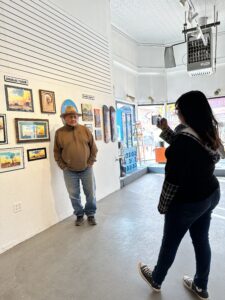 Douglas Yazzie is a watercolorist and painter from Chinle, Arizona. Douglas creates vibrant and detailed paintings inspired by the landscape, culture and history of his hometown. His watercolor paintings are widely collected and each one shows his impressive skill to manipulate watercolor pigments to create rich and mesmerizing landscape scenes. He can be found in many different art markets around Diné Bikéyah and surrounding cities. His wife is also an accomplished beadwork artist who often travels with him as he sells his artwork.
Douglas Yazzie is a watercolorist and painter from Chinle, Arizona. Douglas creates vibrant and detailed paintings inspired by the landscape, culture and history of his hometown. His watercolor paintings are widely collected and each one shows his impressive skill to manipulate watercolor pigments to create rich and mesmerizing landscape scenes. He can be found in many different art markets around Diné Bikéyah and surrounding cities. His wife is also an accomplished beadwork artist who often travels with him as he sells his artwork.
Shandiin DeGroat is a self-taught Diné (Navajo) painter and mixed-media artist born and raised in Kinłitsosinil (Churchrock), New Mexico. He likes to combine his passion for skateboarding/graffiti culture with his Navajo background by merging traditional motifs and Navajo storytelling into his artwork. He carefully balances subject matter with bold colors and intricate linework. He is drawn to using acrylic paints on canvas or paper and is known for his incredible skill of using a script brush to create his line work. For works on paper he enjoys combining different types of mediums like acrylic, watercolor, color pencil, spray paint, markers, and oil pastels. He has also been learning about printmaking and has been experimenting with monotypes and gel plates and has plans to learn silversmithing.
This year he curated a show titled, “Taking Flight” in Albuquerque in January. He was also a featured artist in a Native skateboard deck themed art show, PIVOT at Cahokia in Phoenix, Arizona. He was chosen to participate in Diné College’s Native American Arts Market and the Santa Fe Indian Arts Market (SWAIA) in late September for the first time. He was also recently selected to participate in Harwood Art Center’s emerging artist group show, SURFACE opening in early June. Find him on Instagram @gahsho_boi_3000
Importance
I’ve touched on a lot of things here but the next question is what do we do with this information? What’s the point? It’s not possible to change centuries of thoughts and actions of an entire city overnight. You’re right and that’s not the goal.
There’s a lot to digest in this topic and not everybody will have the same conclusion or opinion and that’s fine. What’s important is how we use this information after we’ve heard it. My goal is to spread awareness of how the economic exploitation, perceived or un-perceived, through trading posts and shops in Gallup are harmful to Native artists. And the need to reevaluate how we as consumers and Native artists interact with such entities. I want to create conversations about how we as a community can support local native artists with their entrepreneurship and self-reliance so that they retain control of their representation. Gallup is my home and has so much potential to create better working relationships with its Native community.
Thank You
Special thank you to gallupARTS for this opportunity and to New Mexico Arts for providing the funding so that artists like myself can share our perspectives the best way we know how: through our art. Thank you to my mom for being a constant source of support and inspiration to me as I make my way through this life. Thank you to my partner Shandiin for the endless encouragement, artistic feedback, guidance and technical support. Thank you to Jacob Malone for staying up all hours with us and helping install the show. Thank you to all the featured artists (Orin Nez, Cathy W., Armond Antonio, Douglas Yazzie, Valencia Chapito, and Peyton) for being so enthusiastic about being a part of the show! Your work was the perfect touch! Thank you to all my art friends and patrons. You are my inspiration to keep dreaming bigger!
